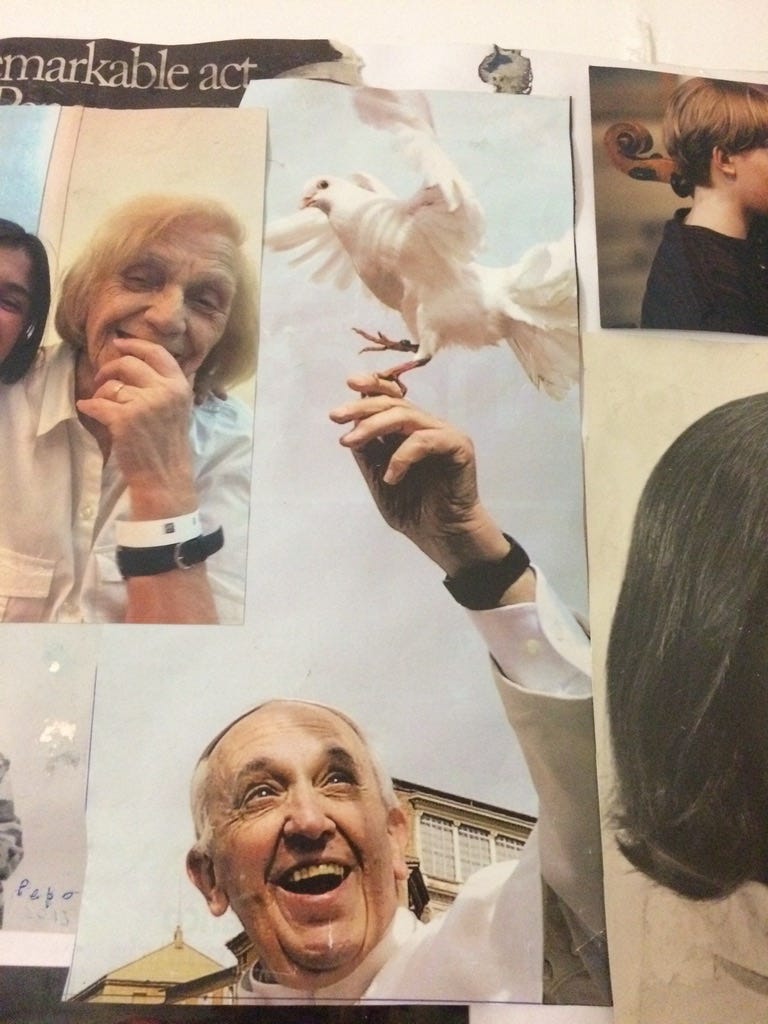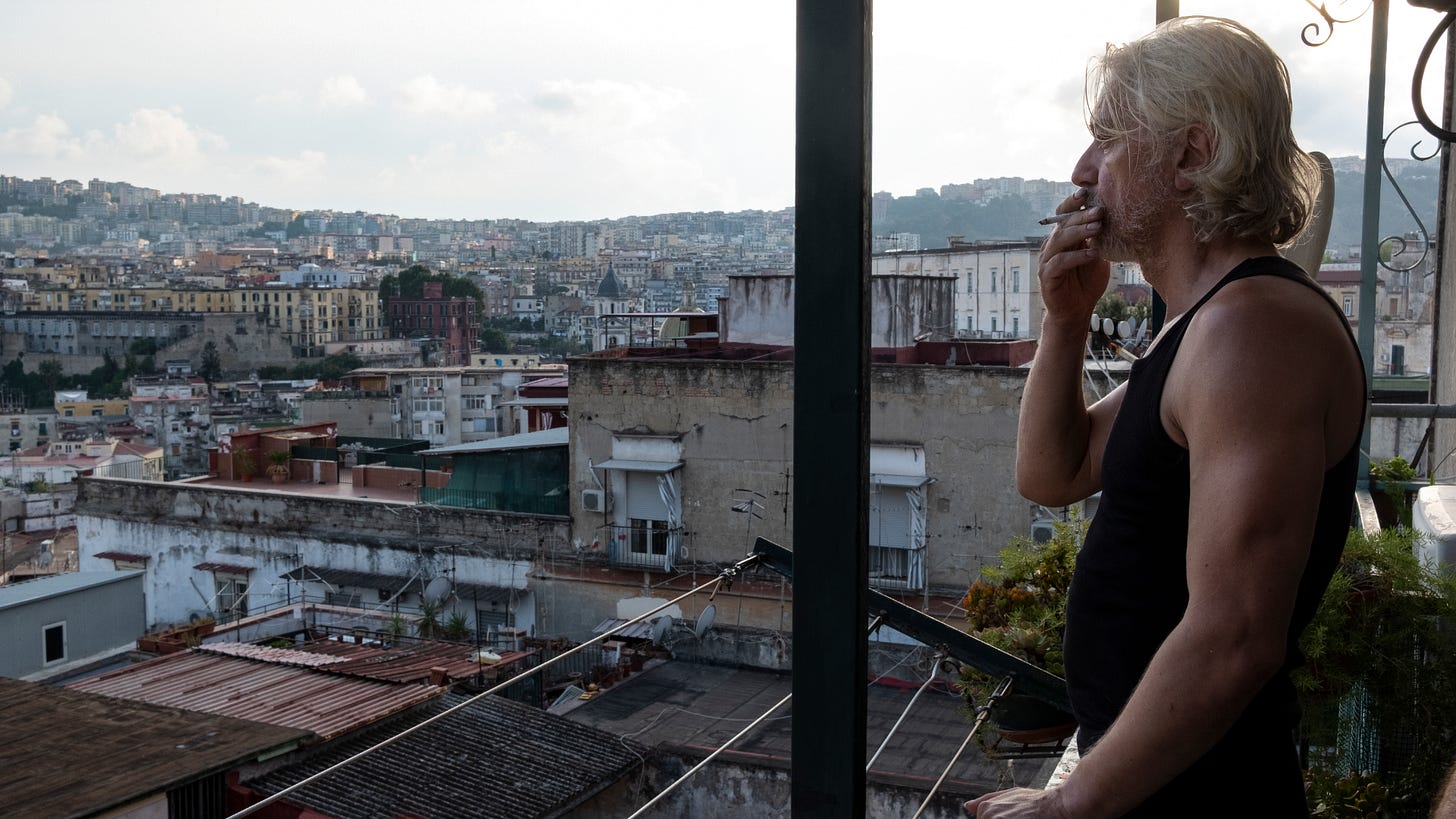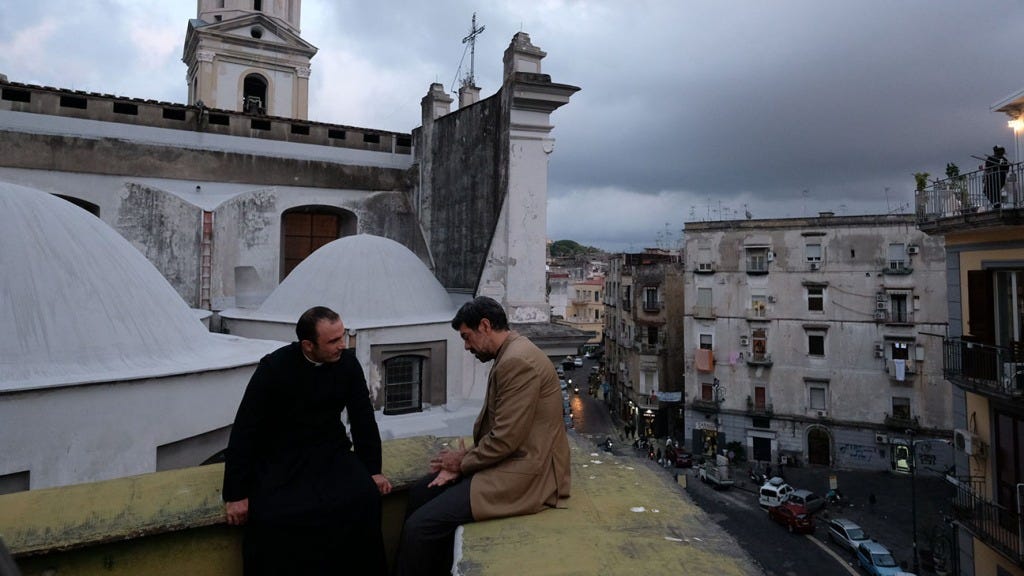Nostalgia review: the past is just as you left it... or is it?
This slow and reminiscing drama explores what really changes when we leave. Plus, another lesson in the history of Christianity!
*mild spoilers that do not ruin the plot ahead!*
This was another one of those films where I became giddy with anticipation after watching the trailer. This seems to be happening a lot, which risks being bitterly disappointed when it doesn’t live up to the hype that I’ve created inside my head. The crushing dismay of unmet excitement has been a problem before, and I will write about it when I finally force myself to watch Everything Everywhere All at Once from start to finish, something that I am absolutely not looking forward to, having walked out of Kriterion after the first hour because it sucks.
But back to the matter at hand!
Nostalgia follows Felice (played by Pierfrancesco Favino), an Italian businessman who has been living in the Arab world for the last 40 years. On his wife’s encouragement, he returns home to Naples to visit his elderly mother Teresa. The scenes between them are fraught with tenderness, as Teresa struggles to come to terms with the fact that her baby is now having to take care of her; he bathes her, clothes her, and tries to find her somewhere more pleasant to spend the end of her life in peace. I don’t remember what happened for the next ten minutes because I was too busy sobbing remembering my own tiny Italian grandmother who went to join all the former popes in heaven back in 2020 (I imagine she’s having a blast, finally allowed to drink gin again after being ill and off the sauce on doctor’s orders in her last few years).
Felice settles into Neapolitan life, looking at apartments to buy and maintaining contact with his wife who is back in Cairo. He moves his mother from her dark and cramped apartment to a beautiful and bright home that he shares with her, with a lemon tree in the garden. While he retraces the steps he took as a boy in Naples, Felice finds himself checking over his shoulder. The motorcycle that he purchased the week before is set alight and thugs break into his home, daubing DISAPPEAR on the walls. Amongst these scenes we see flashbacks from his youth; racing a motorcycle around the ancient city and hanging out doing teenage boy stuff with his best friend Oreste, a fair haired youth contrasting with Felice’s more Mediterranean complexion. Meanwhile, we see shots of an older fair haired man in the gloom of his home, overlooking the city.
Teresa eventually passes away and Felice befriends Don Luigi, a local priest who is deeply invested in his community and leads her funeral. Don Luigi provides a safe space for the young people of this part of town which is in the tight grip of the mafia. There is a prison-style gym in the church and an orchestra which lends instruments to the young people for free. Felice also runs into Raffaele, an old friend of Teresa who recognises him in a restaurant, though Felice does not remember him. Separately, Felice enquires about his childhood friend Oreste, asking if he is still around. Both Don Luigi and Raffaele respond with horror, explaining that Oreste is head of the local Camorra mafia, who violently control the city. Raffaele begs Felice to not go looking for him. The fair haired man hiding in the shadows of his hilltop lair? No points for guessing who that is.
Don Luigi’s response is more extreme; he furiously explains that keeping local youths from being tempted into gang life is his full time job. He invites Felice to join him on his rounds as he visits local families, many of whom are involved in local criminal activity. These local teenagers aren’t always drawn towards a life of crime because of the glamorous danger of it all; sometimes it’s what their families have decided for them. Don Luigi’s interactions with these families are extraordinarily bold. He is extremely persuasive and openly questions the young people, in front of their families, whether their decisions are their own. It is apparent how strong his social status as a religious leader is, allowing him to have these extremely frank conversations with objectively scary people. His commitment to his vocation is palpable.
Despite these warnings, and having seen how Don Luigi has his work cut out protecting the city’s youth from the mafia, Felice is determined to reconnect with his old friend Oreste. Felice seems convinced that the brotherly bond they forged when they were still boys will offer him protection. However, we also get a glimpse into their friendship in a series of flashbacks. Perhaps Felice’s sudden move to Beirut at the age of 15 was not just because of a job offer from an uncle. Perhaps there are reasons for Oreste to question the strength of the bond that Felice so earnestly believes they still share. Felice secretly makes arrangements to visit his old friend, and stubbornly continues to exist and thrive in his hometown. He spends more time with Don Luigi’s youths, as they in turn are instructed to never let Felice walk around the city unaccompanied. He buys an apartment and books flights for his wife to join him. Everything seems to be coming together nicely. Will Felice’s meeting with his old friend be the emotional reunion he wants, or does Oreste have some unfinished business to discuss? Well you’ll just have to go and see!
Today there are no big spoilers. I have managed to resist. Aren’t I brave.
The setting is the Rione Sanità district of Naples, a neighbourhood with high poverty that has been forgotten by the state, allowing organised crime to govern instead. A quick google search will turn up travel tips for the “liveliest” district of Naples, and Time Out lists it as the 20th coolest neighbourhood in the world. These sorts of lists are usually indicative that rent is about to go up and the make me want to claw my own eyes out. Spots that I’ve visited on the list are Mile End, the expensive hip bit of Montreal; Margate, where all the young cool families who are sick of London move to now that Brighton is too expensive; Walthamstow, where white middle class parents buy houses and price out locals of colour; my old home of Amsterdam Noord, which has about 5, maybe 10 good years left before it loses everything that makes it special; and Neukölln in Berlin, obviously. Honestly, who wrote this? I’m not even going to link it, because I’m petty and vindictive.
As much as mind numbingly dull writers for these sorts of publications wish that they were making some sort of tangible difference to the world with their trash journalism, framing neighbourhoods like Rione Sanità as “cool” and “lively” obscures the grim reality for locals there. It’s almost like tourism isn’t the magical answer to structural societal problems? You total fucking morons. Please get a real job!
Rione Sanità’s history is far more fascinating than its touristic potential. The name translates literally to “healthy neighbourhood”, which may not seem apt for somewhere so poverty stricken. It refers to the fact that the air in the neighbourhood was the cleanest in all of Naples back in 1500 (that and more great facts right here!). Like all old Italian cities, it boasts beautiful architecture and churches and all those sorts of things. But it’s what lurks beneath the streets of Rione Sanità that sets it apart.
Below the sacred floors of the city’s churches lie the catacombs of San Gennaro and San Gaudioso, paleo-Christian burial sites that show the city’s ancient links to Christianity. But Celeste, I hear you cry, there are catacombs under loads of cities. People have been burying the dead underground like this for ages. Ok yes, that is all true. But the people of Naples have a peculiar relationship with the dead. The Fontanelle Cemetery, cavernously carved into a hillside in the city, is where thousands upon thousands of the unnamed dead have been buried since the 16th century. As various plagues and epidemics ravaged Naples throughout the centuries, it became something of a dumping ground where masses could be left to decay, anonymously, without religious funeral rites or grave markers. It was a place to be avoided; not only was it a place of decay and disease but one of unconsecrated souls, trapped between heaven and earth, forgotten.
Some time in the 19th century, a local priest began the Herculean task of trying to sort through the piles of bones that had gathered, and local volunteers joined in to try and bring some dignity to the dead. These volunteers, being god fearing folk (and usually women) prayed for the souls of the dead and became rather attached to who they found, as they tried to stack and display everything neatly. Soon a tradition began of women choosing a skull to take care of, keeping it clean and making sure it had a dignified afterlife. In return, the skull’s custodians would hope for favours in return. Eventually, this cult of the dead - pezzentelle - became ingrained in Naples’ folklore. But really, it’s not a cult of the dead. In this Catholic paradigm, a burial without rites was not a complete closure of death. These skulls were stuck in an odd purgatorial state, dead on earth but not yet allowed into heaven. To take care of a skull and pray for its soul was an act of pity, and it was hoped that some attention and prayer would bring luck to everyone involved.
The practice of making pets out of skulls got a little out of hand and finally ended in 1969, to let the poor souls get a bit of peace and quiet and wind down the idolatry of it all. The skulls and bones were removed from San Gennaro and San Gaudioso, and the catacombs and Fontanelle were closed to the public until the early 21st century. In 2006, locals began initiatives to open these ancient sites to the public, offering guided tours to tell these fascinating histories of the almost dead. The Guardian has written a great article interviewing those who have used the catacombs to retell the story of this troubled corner of Naples. The co-operative, called La Paranza, are still working hard to make the city’s history its most notable attribute. There is a lot of overlap between Don Luigi’s youth programmes in the film and La Paranza’s real youth initiatives, so it’s nice knowing that Sanità’s youth are being cared for in real life as well as in fiction.

Naples’ catacombs feature briefly in Nostalgia, as Felice wanders through them with one of Don Luigi’s success stories, a young woman who has escaped poverty to get a degree in art history. It’s a short scene, but he seems very moved, especially by a fresco of the fifth century woman bishop Saint Cerula (though some Catholic analysis I found tries very hard to discredit the notion that women were ordained, because they just don’t want us to have nice things).
These souls trapped in the catacombs for centuries and only liberated into heaven because of the good deeds of others, after laying undisturbed for centuries. Felice’s return to his home after what feels like a 40 year self-imposed exile was just meant to be a visit home to see his mother for the last time. He was drawn back in so deeply, finding his hometown so unchanged, its ancient buildings crumbling just like they used to, the grip of local criminality still tight. The locals welcome him back with open arms, and being good friends, warn him that Sanità is no place to be naive. Like the trapped souls, he is one foot in and one foot out. Physically present, but emotionally split between his old life and the new one he has cultivated for decades.
And Felice knows he is the one who has changed. He has converted to Islam, and does not cross himself in church at his mother’s funeral. Having been speaking Arabic for the last few decades, his accent is different and the locals pick up on it. People recognise him and say hello, but he can’t remember them. Felice likes to think that he can just pick up where he left off, and that the problems he didn’t see as a young man would be as small as an adult. The city is the same but the people are different, and I get the feeling that he doesn’t quite see how different everyone has become.
Revelations about Felice’s past and present are drip fed to us throughout the film, slow enough to be indulgent but enough to show us that things are not quite as they seem in Felice’s mind. We watch him confront the disconnect between his rose tinted memories of the place where he grew up, and the place he has returned to a whole lifetime later. In a way, it is quite sweet to see someone who is so clearly an outsider still feeling that sense of belonging. The ties that bind us to places can be strong, and in this case, the strength obscures realities that are more important to perceive. For Felice’s sake, perhaps it’s best that we keep our eyes more open than our hearts.









